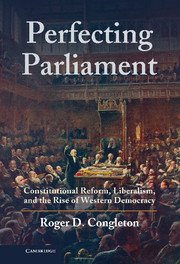Book contents
- Frontmatter
- Contents
- Preface
- 1 On the Origins of Western Democracy
- Part I Sharing Sovereignty
- Part II Historical Evidence on Western Democratic Transitions
- 9 Setting the Stage
- 10 Liberalism and Reform in the Transformative Century
- 11 Fine-Grained Constitutional Bargaining
- 12 An Overview of British Constitutional History
- 13 Constitutional Exchange in the United Kingdom
- 14 The Swedish Transition to Democracy
- 15 Constitutional Reform in the Netherlands
- 16 Germany
- 17 The Japanese Transition to Democracy and Back
- 18 The United States, an Exception or Further Illustration?
- Part III Analytical History as Social Science
- Appendix Methodological Approach, Limits, and Extensions
- References
- Index
15 - Constitutional Reform in the Netherlands
From Republic, to Kingdom, to Parliamentary Democracy
Published online by Cambridge University Press: 05 June 2012
- Frontmatter
- Contents
- Preface
- 1 On the Origins of Western Democracy
- Part I Sharing Sovereignty
- Part II Historical Evidence on Western Democratic Transitions
- 9 Setting the Stage
- 10 Liberalism and Reform in the Transformative Century
- 11 Fine-Grained Constitutional Bargaining
- 12 An Overview of British Constitutional History
- 13 Constitutional Exchange in the United Kingdom
- 14 The Swedish Transition to Democracy
- 15 Constitutional Reform in the Netherlands
- 16 Germany
- 17 The Japanese Transition to Democracy and Back
- 18 The United States, an Exception or Further Illustration?
- Part III Analytical History as Social Science
- Appendix Methodological Approach, Limits, and Extensions
- References
- Index
Summary
In contrast to the kingdoms of the United Kingdom and Sweden, the constitutional monarchy of the Netherlands does not extend back to the middle ages. The Netherlands has not always been a kingdom, nor part of some other kingdom, as might be said of Norway and Belgium. From the late sixteenth century until the late eighteenth century, the Republiek der Verenigde Nederlanden (United Provinces of the Netherlands) was a relatively liberal federation of seven sovereign provinces. Its territories consisted of the northern lowlands of the Rhine, and its national policies were jointly selected by a committee of provincial representatives and a stadhouder. The stadhouder’s autonomy was greater than that of contemporary prime ministers and presidents, but his authority was less than that which kings normally had during the seventeenth and eighteenth centuries.
That the kingdom the Netherlands is relatively new makes the lowland kingdom a very useful addition to the present study because it demonstrates that relatively peaceful transitions to democracy within parliamentary systems do not require a long history of negotiations between kings and their parliaments or a deeply rooted, long-standing, authoritarian regime to rebel against. The first half of Chapter Fifteen provides a short history of the Dutch Republic and the origin of the kingdom of the Netherlands. The second half of the chapter focuses on its nineteenth-century transition to parliamentary democracy.
- Type
- Chapter
- Information
- Perfecting ParliamentConstitutional Reform, Liberalism, and the Rise of Western Democracy, pp. 409 - 448Publisher: Cambridge University PressPrint publication year: 2010



